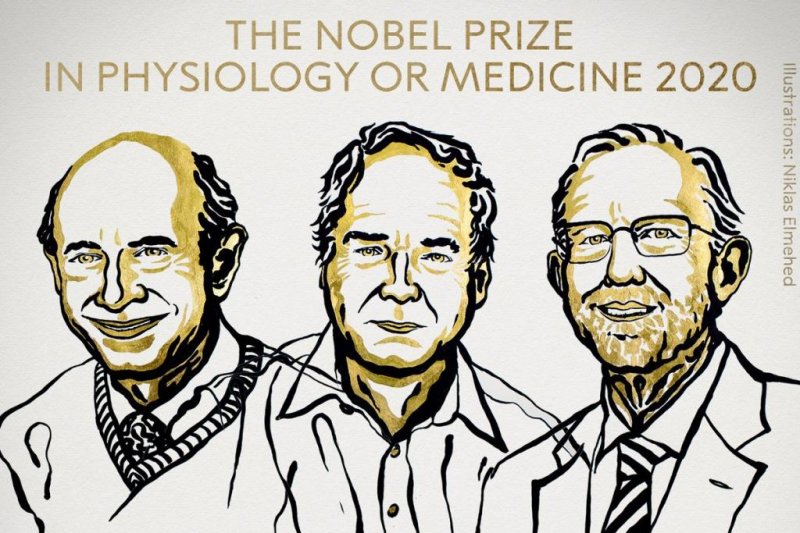
Roger Penrose (L), Reinhard Genzel and Andrea Ghez were awarded the prize on Tuesday. Illustration by Niklas Elmehed/Nobel Media
Oct. 6 (UPI) -- A trio of scientists from the United States, Britain and Germany jointly won the Nobel Prize in Physics on Tuesday for discoveries about black holes, the Norwegian Nobel Institute announced.
British mathematician and physicist Roger Penrose won half of the prize and the other half was shared by German astrophysicist Reinhard Genzel and American astronomer Andrea Ghez.
The prize was announced during a ceremony at the Nobel Assembly at the Karolinska Institute in Sweden, which awards the honor each year.
Penrose was recognized for his work at Birkbeck College in London during the 1960s, during which he used revolutionary mathematical equations to prove the existence of black holes and to determine they were a direct consequence of Albert Einstein's general theory of relativity
Black holes, he showed, are super-heavy masses capturing everything that enters them, even light, hiding singularities in which all the known laws of nature cease. His 1965 paper, "Gravitational collapse and space-time singularities," not only explained black holes but also set the stage for discoveries about the cosmological "Big Bang."
Genzel and Ghez have each focused their work on a region at the center of the Milky Way galaxy called Sagittarius A, where an extremely heavy, invisible object is thought to be pulling million of stars together into a small area at extremely high speeds.
Genzel, a professor at the University of California, Berkeley, and Ghez, who teaches at the University of California, Los Angeles, each were honored for developing new techniques in which powerful telescopes can be used to observe Sagittarius A and uncover new information about a powerful black hole at the center of the galaxy.
"The discoveries of this year's Laureates have broken new ground in the study of compact and supermassive objects," said David Haviland, chair of the Nobel Committee for Physics.
"But these exotic objects still pose many questions that beg for answers and motivate future research. Not only questions about their inner structure, but also questions about how to test our theory of gravity under the extreme conditions in the immediate vicinity of a black hole."
The Nobel Institute's prize for medicine was awarded Monday to Americans Harvey J. Alter, Charles M. Rice and Briton Michael Houghton for their work on curing Hepatitis C.
The Nobel Prize in Chemistry will be announced Wednesday, to be followed by the literature prize on Thursday, the peace prize on Friday and the prize for economic sciences on Oct. 12.
U.S., British hepatitis C researchers win Nobel Prize in Medicine

Americans Harvey Alter and Charles Rice and Briton Michael Houghton were honored Monday for their work with hepatitis C. Image by Niklas Elmehed/Nobel Foundation
Oct. 5 (UPI) -- Three scientists who each played a role in finding a cure for hepatitis C have won this year's Nobel Prize in Physiology or Medicine, the Nobel Foundation announced Monday.
Americans Harvey J. Alter and Charles M. Rice and Briton Michael Houghton won the 2020 prize for their separate work in battling hepatitis C, a blood-borne disease that causes cirrhosis of the liver and liver cancer.
The disease is associated with significant morbidity and mortality and causes more than 1 million deaths per year worldwide, making it a global health threat on a scale comparable to HIV infection and tuberculosis.
The prize was announced during a ceremony at the Nobel Assembly at the Karolinska Institute in Sweden, which awards the honor each year.
Two other types of hepatitis -- A and B -- had been identified earlier, but a still-unknown form had continued to affect blood transfusion patients.
In the 1970s, Alter, working at the U.S. National Institutes of Health, first showed that the condition was caused by a previously unknown, distinct virus, later named the hepatitis C virus.
Identifying the virus, however, eluded researchers for more than a decade. Houghton, then working for the Chiron Corp. in California, was able to isolate the genetic sequence of the virus in 1989, providing a key breakthrough.
With the virus identified, researchers still needed to prove that it alone was capable of causing hepatitis. Rice, a scientist at Washington University in St. Louis, provided the link in 2005 after eight years of research.
The scientists' contributions have "essentially eliminated post-transfusion hepatitis in many parts of the world, greatly improving global health," the Nobel Committee for Physiology or Medicine said.
"Their discovery also allowed the rapid development of antiviral drugs directed at hepatitis C," it added. "For the first time in history, the disease can now be cured, raising hopes of eradicating hepatitis C virus from the world population."
The Nobel Institute's two other scientific prizes -- for physics and chemistry -- will be announced Tuesday and Wednesday. They will be followed by the literature prize on Thursday, the peace prize on Friday and economic sciences on Oct. 12.
No comments:
Post a Comment